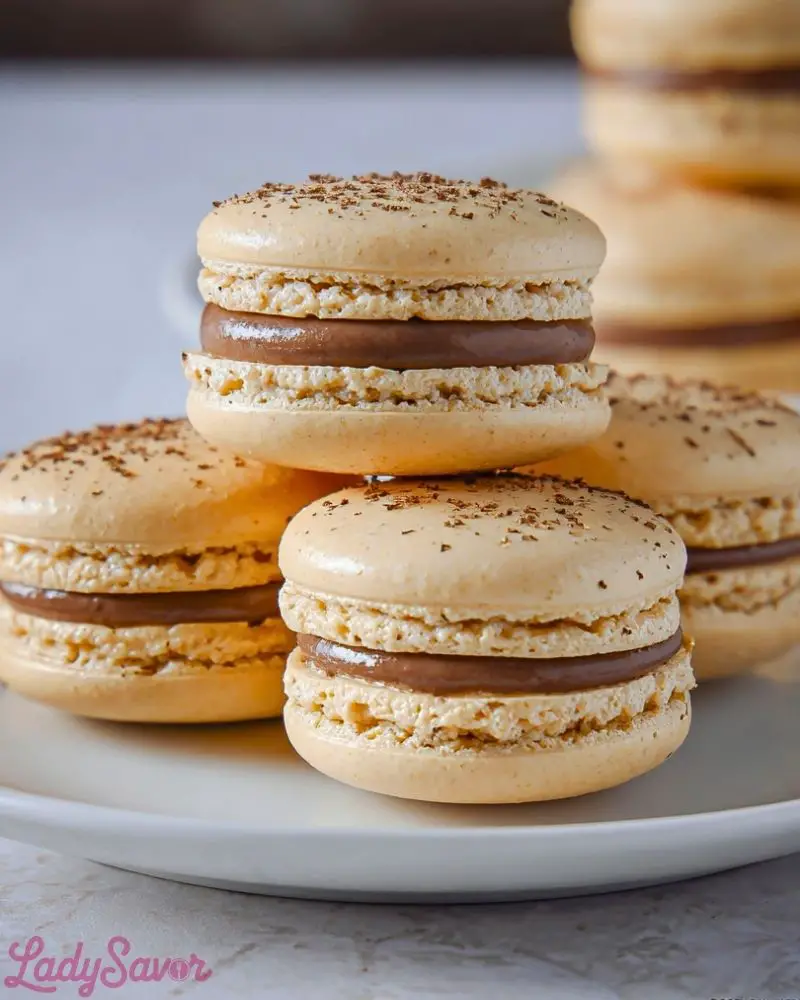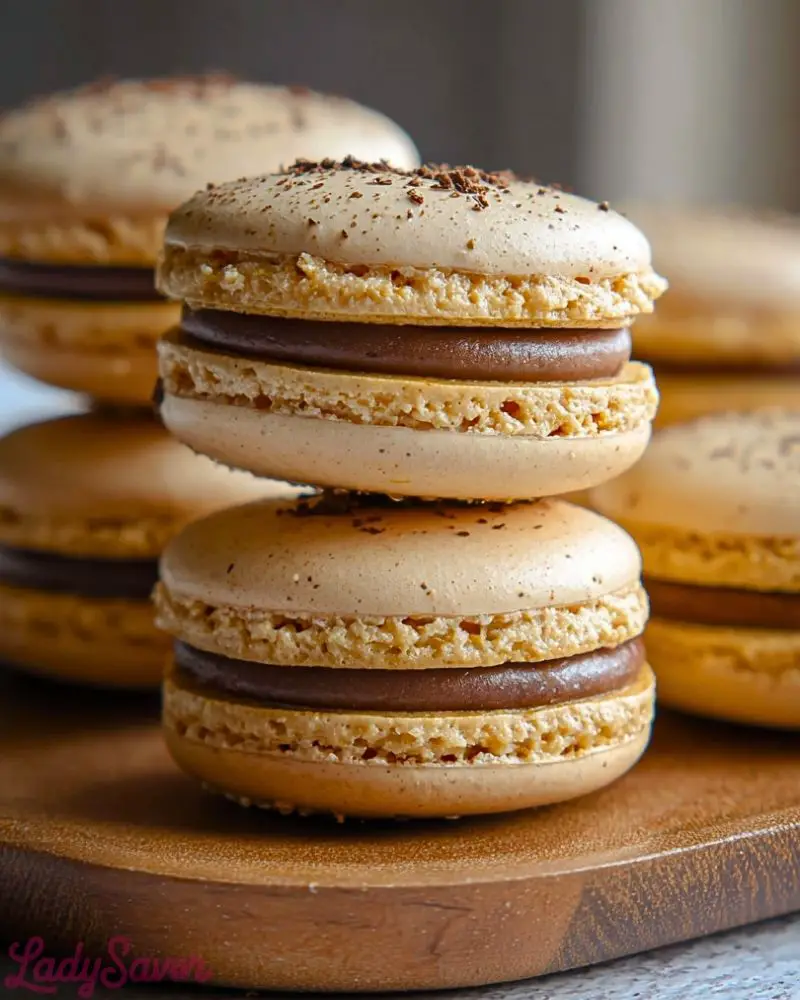Coffee Macarons are a delicate, crisp-yet-chewy French confection that offers a perfect bite of sophistication. These beauties pair a light almond meringue shell with a rich, creamy coffee ganache filling, creating a divine treat for lovers of both desserts and espresso. With a dusting of fine coffee powder or chocolate shavings on top, they look as indulgent as they taste.

The real charm of Coffee Macarons lies in their balance—nutty, mildly sweet shells meet the bold, aromatic bitterness of coffee. They’re not just desserts; they’re tiny moments of luxury, ideal for gifting, serving at afternoon tea, or simply enjoying with a cappuccino. If you’re ready to master a bakery-level classic in your own kitchen, this is the macaron to start with.
Why You’ll Love This Coffee Macarons Recipe
- Elegant and Impressive: These macarons look straight out of a patisserie window.
- Perfect Texture: Crisp outer shell with a soft, chewy center.
- Bold Flavor: Rich espresso flavor in every bite, balanced with the almond sweetness.
- Make-Ahead Friendly: They store well and actually improve in flavor after a day.
- Gluten-Free Delight: Naturally made without flour—ideal for gluten-free diets.
- Customizable: Add chocolate drizzle or sprinkle sea salt for flair.
- Rewarding Challenge: Great for experienced bakers or those ready to level up.
- Perfect Gift: Box them up for birthdays, holidays, or just-because moments.
Preparation Phase & Tools to Use (Essential Tools and Their Importance)
Making Coffee Macarons requires precision and care, so having the right tools can make all the difference between perfect feet and sad, flat cookies.
- Kitchen Scale: Accuracy is key in macaron making. A scale ensures your almond flour and sugar ratios are spot-on.
- Fine Mesh Sieve: Sift the almond flour and powdered sugar to avoid lumps, giving your macarons a smooth shell.
- Stand Mixer or Hand Mixer: For whipping the egg whites into stiff, glossy peaks. Hand mixing won’t cut it here.
- Silicone Baking Mats or Parchment Paper: These ensure even baking and easy removal of the shells.
- Piping Bags with Round Tip (½ inch): Essential for piping uniform circles that rise and bake evenly.
- Oven Thermometer: Macarons are sensitive to temperature fluctuations; don’t trust your oven’s dial alone.
- Mixing Bowls (Glass or Metal): Plastic can hold grease, which deflates meringue. Stick to clean, dry glass or metal bowls.
- Cooling Rack: To cool the baked macarons evenly without moisture buildup on the bottoms.
Preparation Tips
Before diving into baking, here are a few smart steps to set yourself up for macaron success:
- Age Your Egg Whites: Let them sit uncovered in the fridge for 24–48 hours. This helps reduce moisture and improves meringue stability.
- Use Room-Temperature Ingredients: Especially egg whites and butter for the ganache—it helps them mix better.
- Wipe Tools with Vinegar: Remove grease traces from bowls and whisks to help your egg whites whip properly.
- Weigh, Don’t Scoop: Measuring almond flour and powdered sugar by weight prevents inconsistencies.
- Practice Piping Circles: Use a macaron template under your mat or parchment to keep sizes uniform.
- Let the Shells Rest: After piping, let the macarons rest for 30–60 minutes until they form a skin—this prevents cracking during baking.
- Rotate Your Tray Mid-Bake: Ensures even cooking if your oven has hot spots.
- Cool Before Filling: Never fill warm shells, or the ganache will melt and ruin the texture.
Ingredients for This Coffee Macarons Recipe
Here’s everything you’ll need to craft these elegant, coffee-infused delights—from the crisp shell to the luscious filling:
For the Macaron Shells:
- 100g almond flour (finely ground and sifted)
- 100g powdered sugar
- 90g egg whites (aged at room temperature)
- 90g granulated sugar
- ½ tsp cream of tartar (optional, helps stabilize the meringue)
- 1 tsp instant espresso powder (dissolved in ½ tsp hot water)
- A pinch of salt
For the Coffee Ganache Filling:
- 100g dark or semi-sweet chocolate (finely chopped)
- 80ml heavy cream
- 1 tsp instant espresso powder
- 1 tsp unsalted butter (for gloss and smoothness)
Optional Garnish:
- Finely grated dark chocolate or cocoa powder for dusting
This ingredient list yields about 24 sandwiched macarons (48 shells). Scale up or down based on your baking needs.

Step 1: Prepare the Dry Ingredients
Sift the almond flour and powdered sugar together into a large mixing bowl. If there are any coarse bits left in the sieve, discard them. This step ensures smooth macaron shells with a delicate finish.
Step 2: Make the Meringue
In a clean metal or glass bowl, start beating the egg whites on medium speed until foamy. Add the cream of tartar and a pinch of salt. Gradually add the granulated sugar and beat until stiff, glossy peaks form. Gently mix in the dissolved espresso paste to flavor the meringue.
Step 3: Macaronage (Folding Process)
Add the sifted dry ingredients into the meringue in two parts. Using a rubber spatula, fold the mixture gently but firmly. You’re aiming for a lava-like consistency—it should flow off the spatula in thick ribbons and settle into itself within 10–15 seconds.
Step 4: Pipe the Shells
Transfer the batter into a piping bag fitted with a round tip. Pipe small, even rounds (about 1.5 inches in diameter) onto a parchment- or silicone-lined baking sheet. Tap the trays firmly on the counter a few times to release air bubbles. Pop any surface bubbles with a toothpick.
Step 5: Rest the Shells
Let the piped macarons sit at room temperature for 30 to 60 minutes until they develop a skin. You’ll know they’re ready when they’re no longer sticky to the touch. This skin helps form the classic macaron “feet” during baking.
Step 6: Bake
Preheat the oven to 300°F (150°C). Bake one tray at a time for 14–16 minutes. Look for shells that are set and slightly pulling away from the parchment or mat. Avoid overbaking—they should remain pale on top.
Step 7: Cool Completely
Allow the macarons to cool completely on the tray before removing them. Attempting to lift them while warm may cause them to break or stick.
Step 8: Make the Coffee Ganache
Heat the cream in a small saucepan until it just begins to simmer. Pour it over the chopped chocolate and espresso powder in a bowl. Let it sit for 1 minute, then stir gently until smooth. Add the butter and stir until glossy. Chill the ganache in the fridge until it’s thick enough to pipe.
Step 9: Fill and Assemble
Pipe a dollop of ganache onto the flat side of half the macaron shells. Top with another shell, gently pressing to sandwich. For best results, refrigerate the assembled macarons in an airtight container for 24 hours to allow flavors to mature.
Notes
- Aging Egg Whites: While optional, this step helps reduce moisture and creates a more stable meringue. Simply separate your egg whites and let them sit loosely covered in the fridge for 24–48 hours.
- Resting Time: Humidity can affect resting. On humid days, use a fan near the macarons to help the skin form faster.
- Flavor Intensifies Over Time: Macarons taste best the next day, after the shells absorb some moisture from the filling and become perfectly chewy.
- Custom Touch: Add a tiny pinch of cinnamon or vanilla extract to the ganache for a twist on the coffee flavor.
- Freezing: You can freeze filled macarons for up to a month. Thaw overnight in the fridge before serving.
Watch Out for These Mistakes While Cooking
- Overmixing the Batter: It will spread too thin and lose structure. Stop folding when the batter flows like thick lava.
- Undermixing the Batter: Leads to lumpy, cracked shells. Make sure it flows slightly but doesn’t run.
- Skipping the Rest Phase: If the shells don’t form a skin, they may crack or puff unevenly in the oven.
- Incorrect Oven Temperature: Too hot and the shells brown; too cool and they won’t rise properly. Use an oven thermometer!
- Opening the Oven Door: Avoid during the first 8–10 minutes of baking or the macarons might collapse.
- Oily or Wet Almond Flour: Choose a dry, finely milled almond flour. If it feels damp, dry it in the oven at a low temperature.
- Using Greasy Bowls or Tools: Any fat residue will ruin your meringue—wipe down with vinegar first.
- Underwhipped Meringue: Stop only when you see stiff, shiny peaks that don’t droop or slide.
What to Serve With Coffee Macarons?
Coffee Macarons are incredibly versatile when it comes to pairings. Whether you’re going for elegance or comfort, these combinations elevate the experience:
8 Recommendations
- Espresso or Cappuccino – The obvious but perfect match. The coffee-on-coffee combo enhances every bite.
- Vanilla Bean Ice Cream – A creamy, neutral base that complements the bold espresso notes of the macarons.
- Fresh Berries – Their tartness balances the sweetness and adds a touch of color to your serving plate.
- Dark Chocolate Squares – A small, bitter square enhances the mocha element and cuts the sweetness.
- Mascarpone Cream – Light and slightly tangy, it’s a luxurious dip or spread alongside your macarons.
- Hazelnut Liqueur (Frangelico) – For adult pairings, this nutty spirit echoes the almond base in the shells.
- Chai Tea Latte – The spices contrast beautifully with the deep coffee flavor of the filling.
- Mini Cheesecakes – Serve macarons as a garnish or side on dessert platters for an elegant finishing touch.
Storage Instructions
- Refrigeration: Store filled Coffee Macarons in an airtight container in the refrigerator for up to 5 days. The flavor and texture actually improve after 24 hours, as the shells absorb moisture from the filling.
- Freezing: Macarons freeze well. Place them in a single layer in an airtight container with parchment between layers, and freeze for up to 1 month. Thaw in the fridge overnight before serving.
- Unfilled Shells: Can be stored at room temperature in an airtight container for 3–4 days or frozen for longer storage.
Estimated Nutrition
Per 1 filled macaron (based on 24 total):
- Calories: 95
- Total Fat: 5g
- Saturated Fat: 2.5g
- Unsaturated Fat: 2g
- Trans Fat: 0g
- Cholesterol: 10mg
- Sodium: 10mg
- Carbohydrates: 11g
- Fiber: 1g
- Sugar: 9g
- Protein: 2g
- Serving Size: 1 macaron
Note: Nutrition values are estimates and can vary based on specific ingredients used.
Frequently Asked Questions
1. Why did my macarons crack during baking?
Most likely, the shells didn’t rest long enough before baking or your oven temperature was too high. Ensure a proper skin forms and use an oven thermometer for accuracy.
2. Can I make Coffee Macarons without a scale?
It’s strongly discouraged. Macaron recipes rely on weight-based precision for consistent results. A scale ensures accuracy far better than volume measurements.
3. How do I know when the macaron batter is ready?
The batter should flow like thick lava and form ribbons that settle within 10–15 seconds. If it’s too runny or too thick, the shells won’t bake correctly.
4. Can I use espresso instead of instant espresso powder?
No—liquid espresso adds too much moisture. Use instant espresso powder dissolved in minimal water for flavor without disrupting texture.
5. Why are my macarons hollow inside?
Overmixing or underbaking can cause hollow shells. Aim for stiff meringue peaks and be gentle during macaronage. Also, check your oven for even heating.
6. Do I need to age my egg whites?
It’s optional but recommended. Aged egg whites produce a more stable meringue and can help improve texture and structure.
7. Can I make them ahead of time?
Yes! In fact, macarons taste better the next day. Store them in the fridge in an airtight container for up to 5 days or freeze for longer storage.
8. Can I add other flavors to this recipe?
Absolutely. Try adding a touch of vanilla or cinnamon to the ganache, or sprinkle cocoa or espresso powder on the shells before baking for variation.
Conclusion
Coffee Macarons are a delicious way to bring the charm of French patisserie into your own kitchen. While they require patience and precision, the result is an exquisite treat with deep espresso notes and a chewy-almond shell. They make for the perfect gift, dessert centerpiece, or indulgent bite alongside your morning brew. With the right techniques and tips from this guide, you’re well on your way to mastering the art of macarons—coffee-style.

Coffee Macarons
- Total Time: 46 mins
- Yield: 24 macarons 1x
Description
Coffee Macarons are an elegant French treat with crisp almond meringue shells and a rich, creamy espresso ganache filling. Perfectly balanced between sweet and bold, they are ideal for special occasions, gifts, or an indulgent coffee companion.
Ingredients
100g almond flour
100g powdered sugar
90g egg whites
90g granulated sugar
0.5 tsp cream of tartar
1 tsp instant espresso powder
0.5 tsp hot water
1 pinch salt
100g dark chocolate
80ml heavy cream
1 tsp instant espresso powder
1 tsp unsalted butter
Instructions
1. Sift almond flour and powdered sugar together and discard coarse bits.
2. Beat egg whites until foamy, then gradually add sugar, cream of tartar, and salt; whip to stiff peaks.
3. Mix dissolved espresso into meringue.
4. Fold in dry ingredients in two parts to achieve lava-like batter.
5. Pipe onto baking mats or parchment-lined trays; tap to release bubbles.
6. Rest 30–60 minutes until shells are no longer sticky.
7. Bake at 300°F (150°C) for 14–16 minutes.
8. Cool completely before removing.
9. Heat cream and pour over chopped chocolate and espresso; stir until smooth.
10. Add butter and chill ganache until pipeable.
11. Pipe ganache on half the shells; top with remaining shells.
12. Refrigerate 24 hours before serving for best texture.
Notes
Macarons taste better after a day in the fridge.
Freeze up to one month in airtight containers.
Avoid overmixing or undermixing during macaronage.
Use aged egg whites for best results.
- Prep Time: 30 mins
- Cook Time: 16 mins
- Category: Dessert
- Method: Baking
- Cuisine: French
Nutrition
- Serving Size: 1 macaron
- Calories: 95
- Sugar: 9g
- Sodium: 10mg
- Fat: 5g
- Saturated Fat: 2.5g
- Unsaturated Fat: 2g
- Trans Fat: 0g
- Carbohydrates: 11g
- Fiber: 1g
- Protein: 2g
- Cholesterol: 10mg
Keywords: coffee macarons, espresso dessert, French cookies

